topwater
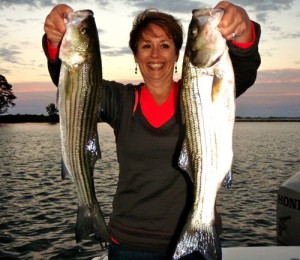 No, this isn’t an entry about breakfast cereal. It’s about skinny-water fishing on the Chesapeake Bay where conditions are perfect for the snap, crackle, and pop of topwater lures. That’s the good news. The bad news is that muddy water has all but eliminated fishing in the main stem of the Bay. The tributary rivers are clearing, but water in the main channel remains deeply stained. Satellite photos show a sediment plume stretching all the way down to the mouth of the Patuxent River. It’s too trashy to troll, too muddy to catch bait, and too dirty to bottom fish. Thank goodness for the versatility of light tackle! While many anglers are sitting on their hands lamenting the impossible conditions, light tackle fishermen are enjoying a banner fall. Since the shallow-water bite is tasty, I thought it might be interesting to look at three basics premises of topwater casting – let’s call ’em snap, crackle, and pop. Read More!
No, this isn’t an entry about breakfast cereal. It’s about skinny-water fishing on the Chesapeake Bay where conditions are perfect for the snap, crackle, and pop of topwater lures. That’s the good news. The bad news is that muddy water has all but eliminated fishing in the main stem of the Bay. The tributary rivers are clearing, but water in the main channel remains deeply stained. Satellite photos show a sediment plume stretching all the way down to the mouth of the Patuxent River. It’s too trashy to troll, too muddy to catch bait, and too dirty to bottom fish. Thank goodness for the versatility of light tackle! While many anglers are sitting on their hands lamenting the impossible conditions, light tackle fishermen are enjoying a banner fall. Since the shallow-water bite is tasty, I thought it might be interesting to look at three basics premises of topwater casting – let’s call ’em snap, crackle, and pop. Read More!
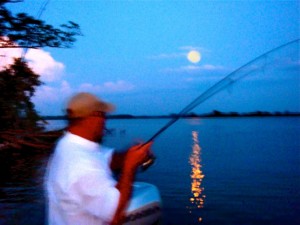 The main channel of the Chesapeake is currently closed to most fishing due to dense, muddy water. Debris fields containing trees, logs, railroad ties, even 55-gallon drums and partially-submerged refrigerators make it nearly impossible to navigate anywhere near the Bay Bridge. The Susquehanna River remains near flood stage, so there is more bad water and trash to come. What’s a light tackle fisherman to do? Go east, young man – go east and go shallow. If you aren’t fishing the shoreline right now, you’re missing some of the most spectacular top-water action of the year. September is almost always a great month for top-water fishing, and it’s even better now since fish have been pushed out of the muddy waters of the channel toward the shorelines. Better yet, the high water makes it even easier to get our boats in tight and fish the current swept banks. Read More!
The main channel of the Chesapeake is currently closed to most fishing due to dense, muddy water. Debris fields containing trees, logs, railroad ties, even 55-gallon drums and partially-submerged refrigerators make it nearly impossible to navigate anywhere near the Bay Bridge. The Susquehanna River remains near flood stage, so there is more bad water and trash to come. What’s a light tackle fisherman to do? Go east, young man – go east and go shallow. If you aren’t fishing the shoreline right now, you’re missing some of the most spectacular top-water action of the year. September is almost always a great month for top-water fishing, and it’s even better now since fish have been pushed out of the muddy waters of the channel toward the shorelines. Better yet, the high water makes it even easier to get our boats in tight and fish the current swept banks. Read More!
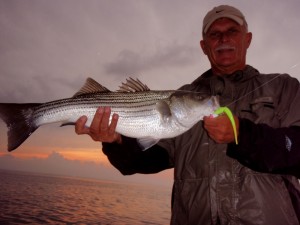 Kent Island is currently under a state of emergency and a mandatory evacuation order. We have decided to ride out the storm since the house we live in – one of the oldest on the island – has survived its share of tropical weather. Most of our neighbors are also staying. I thought it might be interesting to pass along what we’re experiencing here on Kent Island as Hurricane Irene passes through. Reload this page frequently, as I will be posting regular updates along with pictures and video. Some storm trackers predict we are directly in the path of the storm, but most have it passing east of us, just slightly off the Coast of the Delmarva Peninsula. I’m hoping for the easterly path, but we are taking the warnings seriously. This is a fishing website, so most of my observations will be about the hurricane’s impact on the Chesapeake Bay. We don’t live right on the water anymore (thankfully), but we are less than a hundred yards from the closest tidal stream.
Kent Island is currently under a state of emergency and a mandatory evacuation order. We have decided to ride out the storm since the house we live in – one of the oldest on the island – has survived its share of tropical weather. Most of our neighbors are also staying. I thought it might be interesting to pass along what we’re experiencing here on Kent Island as Hurricane Irene passes through. Reload this page frequently, as I will be posting regular updates along with pictures and video. Some storm trackers predict we are directly in the path of the storm, but most have it passing east of us, just slightly off the Coast of the Delmarva Peninsula. I’m hoping for the easterly path, but we are taking the warnings seriously. This is a fishing website, so most of my observations will be about the hurricane’s impact on the Chesapeake Bay. We don’t live right on the water anymore (thankfully), but we are less than a hundred yards from the closest tidal stream.
The Calm Before The Storm
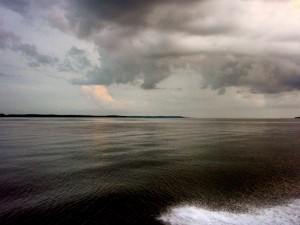 I fished last night and tonight. Every fisherman has heard about how good fishing can be before a storm. Since Hurricane Irene is predicted to be the worst storm in decades, I was hoping for lots of big fish. That didn’t happen. Oh, we caught plenty of fish, but they weren’t the big ol’ good ‘uns I was hoping for. Last night, Rich and I launched out of Matapeake and found breaking bluefish right out in front of the ramp. Finding no Spanish mackerel or rockfish of any side, we ran south. I guess we passed a half-dozen pods of breaking fish on the way, but all the fish were small. I eventually spotted some bigger birds sitting over a drop-off, so we motored over to take a look. There were no fish feeding on the surface, but the fish finder lit up so we started casting jigs. Read More!
I fished last night and tonight. Every fisherman has heard about how good fishing can be before a storm. Since Hurricane Irene is predicted to be the worst storm in decades, I was hoping for lots of big fish. That didn’t happen. Oh, we caught plenty of fish, but they weren’t the big ol’ good ‘uns I was hoping for. Last night, Rich and I launched out of Matapeake and found breaking bluefish right out in front of the ramp. Finding no Spanish mackerel or rockfish of any side, we ran south. I guess we passed a half-dozen pods of breaking fish on the way, but all the fish were small. I eventually spotted some bigger birds sitting over a drop-off, so we motored over to take a look. There were no fish feeding on the surface, but the fish finder lit up so we started casting jigs. Read More!
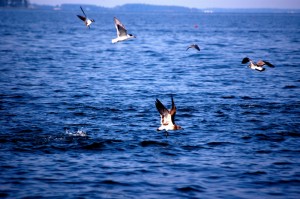 It’s summer and you live in the land of pleasant living. I hope you’re enjoying it. If your idea of fun is sitting in the hot sun, live-lining, soaking bait, or trolling, this entry isn’t for you. But if you like blasting through the spray on a fast boat, swerving around hairpin turns, and stopping on a dime to cast top-water plugs & jigs toward screaming birds over frenzied fish, you’re in the right place to enjoy some of the most exciting action the Bay has to offer. On an average summer day, a knowledgeable light tackle angler will catch more fish by accident than most bait fishermen can catch on purpose in a year. It’s time for running and gunning beneath working birds on the Chesapeake Bay. Summer breakers are here, and it’s your mission to find them. In an earlier segment, I wrote about how important it is to stay as close as possible to hard bottoms when looking for open-water summer fish. In this entry, I’ll say a little about looking for breakers including some strategies for fishing beneath working birds. I’ll also mention some individual species and cover what they might tell us about the fish. Read More!
It’s summer and you live in the land of pleasant living. I hope you’re enjoying it. If your idea of fun is sitting in the hot sun, live-lining, soaking bait, or trolling, this entry isn’t for you. But if you like blasting through the spray on a fast boat, swerving around hairpin turns, and stopping on a dime to cast top-water plugs & jigs toward screaming birds over frenzied fish, you’re in the right place to enjoy some of the most exciting action the Bay has to offer. On an average summer day, a knowledgeable light tackle angler will catch more fish by accident than most bait fishermen can catch on purpose in a year. It’s time for running and gunning beneath working birds on the Chesapeake Bay. Summer breakers are here, and it’s your mission to find them. In an earlier segment, I wrote about how important it is to stay as close as possible to hard bottoms when looking for open-water summer fish. In this entry, I’ll say a little about looking for breakers including some strategies for fishing beneath working birds. I’ll also mention some individual species and cover what they might tell us about the fish. Read More!
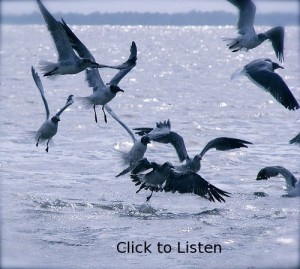 Radios blaring, airplanes buzzing, stereos thumping, outboards droning, helicopters whirring, sirens wailing – Wow! I spent a lot of my time on the water this weekend just listening. Boat shows, trolling tournaments, and sailing regattas made the main stem of the Chesapeake very noisy. The Bay is fully awake from her winter slumber and the crowds are back in force. While we each enjoy the water in our preferred ways, to my thinking fishing should include elements of solitude and stealth. I don’t know about you, but I’d rather pick up aluminum cans at rush hour along I-95 than try to pick off rockfish in the main channel on a busy weekend. I prefer to look off the beaten path for places where I can tune-in to something a little more pleasing than the clamorous dissonance of the masses. At this busy time of the year, I want to listen for the sounds of laughter.
Radios blaring, airplanes buzzing, stereos thumping, outboards droning, helicopters whirring, sirens wailing – Wow! I spent a lot of my time on the water this weekend just listening. Boat shows, trolling tournaments, and sailing regattas made the main stem of the Chesapeake very noisy. The Bay is fully awake from her winter slumber and the crowds are back in force. While we each enjoy the water in our preferred ways, to my thinking fishing should include elements of solitude and stealth. I don’t know about you, but I’d rather pick up aluminum cans at rush hour along I-95 than try to pick off rockfish in the main channel on a busy weekend. I prefer to look off the beaten path for places where I can tune-in to something a little more pleasing than the clamorous dissonance of the masses. At this busy time of the year, I want to listen for the sounds of laughter.
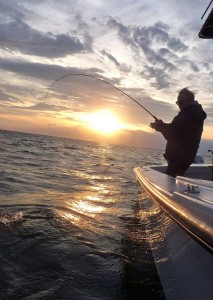 Savvy Chesapeake anglers recognize an event that happens every fall that has significant impact on light tackle fishing. In summer months, the waters in most areas of the Chesapeake Bay stratify so that it is cooler, denser, and saltier down deep, but lighter and fresher near the surface. In the fall, as temperatures cool and strong cold fronts bring lots of wind, the water is stirred up so that the top layer eventually reaches the same density as it is down deep. When that happens the surface water sinks so that for a while, temperatures and salinity are about the same top to bottom. It doesn’t happen all over the Bay at the same time, but it’s easily recognizable to fishermen because we start noticing that fish are feeding at much deeper depths. In some parts of the Maryland portion of the Bay, we are currently experiencing the fall turnover. This can be both good and bad for fishing.
Savvy Chesapeake anglers recognize an event that happens every fall that has significant impact on light tackle fishing. In summer months, the waters in most areas of the Chesapeake Bay stratify so that it is cooler, denser, and saltier down deep, but lighter and fresher near the surface. In the fall, as temperatures cool and strong cold fronts bring lots of wind, the water is stirred up so that the top layer eventually reaches the same density as it is down deep. When that happens the surface water sinks so that for a while, temperatures and salinity are about the same top to bottom. It doesn’t happen all over the Bay at the same time, but it’s easily recognizable to fishermen because we start noticing that fish are feeding at much deeper depths. In some parts of the Maryland portion of the Bay, we are currently experiencing the fall turnover. This can be both good and bad for fishing.


